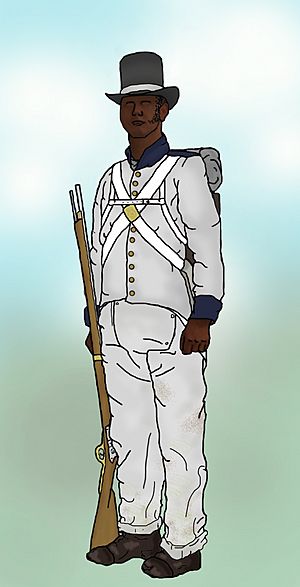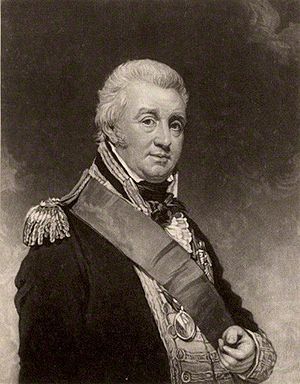Corps of Colonial Marines facts for kids
Quick facts for kids Corps of Colonial Marines |
|
|---|---|

A British Colonial Marine in a light coloured fatigue uniform, worn for performing ordinary duties and a common sight on Tangier Island in Chesapeake Bay but on the battlefield, the red coat of the service uniform would have been worn
|
|
| Active | First Corps: 1808–1815 |
| Country | |
| Branch |
|
| Type | Marine Infantry |
| Size | |
| Garrison/HQ | First Corps: Guadeloupe |
| Patron | Sir Alexander Cochrane |
| Engagements | First Corps:
Second Corps:
|
| Commanders | |
| Notable commanders |
Second Corps: Major George Lewis |
The Corps of Colonial Marines were two special British military groups. They were made up of former Black individuals who had been slaves. These groups served in the Americas and were created by Alexander Cochrane.
The first group existed from 1808 to 1810 during the Napoleonic Wars. The second group was formed during the War of 1812. Both groups were disbanded when the fighting ended. Even though Alexander Cochrane created both, they were not directly connected.
The first Corps was a small unit. It served in the Caribbean from 1808 to 1810. It was formed because the British needed more soldiers there. Local recruits were better at handling tropical illnesses than soldiers from Britain. A law in 1807 said that slaves who joined the British Army became free. So, these new soldiers were considered free when they joined.
The second Corps was much larger. It served from May 1814 to August 1816. Most of this group was in St. Augustine, Florida. A smaller part was at a place called Negro Fort in northwest Florida. This group accepted escaped slaves who had already found freedom with the British.
Creating this armed group of former slaves worried the United States a lot. It was seen as a threat to their slave-owning society. American leaders like Hezekiah Niles strongly criticized the British officers involved.
When the War of 1812 ended, the British left Florida. The Florida part of the Corps was paid and disbanded. Some men went to Bermuda with the British. But most stayed in settlements around the fort. The United States did not like the idea of armed former slaves living freely. This led to the Battle of Negro Fort in 1816. After this battle, the former Marines joined Seminoles and other African Americans moving south.
The Colonial Marines who served on the Atlantic coast left American land. They continued to serve in Bermuda until 1816. Then, the unit was disbanded. These former Marines were resettled on Trinidad.
Contents
The First Corps: Caribbean Service
Rear Admiral Sir Alexander Cochrane started the first Corps of Colonial Marines in 1808. At that time, he was in charge of British naval forces in the Leeward Islands. This was during the Napoleonic Wars.
The British had captured the island of Marie Galante. But the French governor of Guadeloupe attacked it. He heard that many British soldiers were sick. Slaves on Marie Galante helped the British. They were promised freedom if they helped. This way, the British kept control of the island.
Cochrane called these former slaves the Corps of Colonial Marines. More escaped slaves from Guadeloupe joined them. The Corps was paid using money from Marie Galante. They wore uniforms from the Royal Navy. Royal Marine officers commanded them.
After Guadeloupe was taken back, Cochrane kept the Corps. In October 1810, he divided the men. Some went to ships, some to a fort, and others stayed on Marie Galante. They did not fight as a separate group again. But they were still listed as "Colonial Marines" until 1815.
The Second Corps: War of 1812
Cochrane, now a Vice Admiral, became the Commander-in-Chief of British forces in North America in April 1814. He ordered the creation of another Corps of Colonial Marines. Rear Admiral George Cockburn helped carry out this order. This second Corps served with British forces during the War of 1812.
On April 2, 1814, Cochrane made an announcement. He said that anyone wanting to leave their homes would be welcomed by the British. They could join British forces or become free settlers in British lands. This was similar to an earlier promise of freedom in 1775.
Joining and Fighting on the Atlantic Coast
By May 10, Tangier Island off the Virginia coast was taken by the British. It became a safe place for people seeking freedom. Men who arrived could choose to join the navy, become soldiers, or help build Fort Albion.
The Corps officially started on May 18, 1814. Their first fight was a raid on Pungoteague Creek on May 30, 1814. They helped capture an American artillery battery. Captain James Ross praised their bravery and obedience. One soldier, Michael Harding, was killed, but it made the others fight even harder.
Cockburn was impressed with the new recruits. He said they were "getting on astonishingly" and were "really fine fellows." The Corps then took part in the Chesapeake campaign. Cockburn later wrote that they fought "unexpectedly well."
Members of the Corps fought alongside Royal Marines. They took part in many raids. For example, on June 15, 1814, 30 Colonial Marines joined 180 Royal Marines in a raid on Benedict. Nine days later, they attacked an artillery battery at Chesconessex Creek.
More Royal Marines arrived on July 19. This allowed for bigger attacks. The Colonial Marines joined attacks on Bladensburg and Washington in August 1814. One company fought at the Battle of Bladensburg. Two other companies helped with the burning of Washington. One of the groups setting fires was led by Second Lieutenant Lewis Agassiz. The Colonial Marines had one man killed and three wounded in these actions.
In September 1814, three companies of Colonial Marines joined Royal Marines. They formed the 3rd Battalion. Later that month, all three companies fought at the Battle of North Point in Maryland. More companies were added in December 1814 and early 1815.
The Corps lost some men in battles. But more men died from disease on Tangier Island. A sickness in the winter of 1814 killed 69 men. The Corps had about 200 men on Tangier Island that autumn.
The Corps' last duty in the War of 1812 was in Georgia. This was from December 1814 to March 1815. Admiral George Cockburn wanted to stop trade and troop movement in the south. Part of the Corps helped in the successful British attack on Fort Point Peter. They helped about 1,485 slaves escape from southeast Georgia.
Joining and Fighting on the Gulf Coast
Besides outposts on the Atlantic coast, the British had one on the Gulf coast. This was at Prospect Bluff in Spanish East Florida. This area attracted Creek Indians and Black Seminoles.
George Woodbine and some Royal Marines arrived in May 1814. They brought gifts and weapons for the Indians. A fort was built there. Cochrane sent Edward Nicolls to manage things at Prospect Bluff.
Nicolls arrived with 112 Royal Marines and many weapons and uniforms. He started his "battalion" on August 26, 1814. More escaped slaves joined in Pensacola. But they had to return to Prospect Bluff in November. This was after the Americans captured Pensacola.
After the War
The war ended in February 1815. The European companies of the 3rd Battalion were sent back to Britain. The battalion was then renamed the 3rd Battalion, Colonial Marines. It had six companies of Colonial Marines.
They served as guards at the Royal Naval Dockyard in Bermuda. They were then taken to Trinidad and disbanded on August 20, 1816.
Near what is now Princes Town, these former Colonial Marines started a free farming community. They were known as the Merikins. They were given land plots of about 16 acres. These settlements did well. In 1847, their ownership of the land was officially recognized. Their descendants still live there and celebrate their history each year.
The group in Florida had grown to about 400 men. They were paid and disbanded when the British left. A few men went to Bermuda with the British. Others stayed in settlements around the Fort.
Southern plantation owners saw this group of armed former slaves as a danger. This led to the Battle of Negro Fort in July 1816. This battle also started the First Seminole War. Two former officers of the Corps were executed in 1818. It is believed that some former Colonial Marine refugees escaped to the Bahamas in 1822. They founded Nicholls Town on Andros Island. This community still exists today.
See also
- Merikins
- West India Regiment


